Discover the elegance of the past with free vintage sewing patterns PDFs! Bring timeless charm to your wardrobe by downloading and creating authentic garments inspired by bygone eras—a treasure trove of retro fashion awaits!
What Are Vintage Sewing Patterns?
Vintage sewing patterns are historical templates for creating garments‚ accessories‚ and home decor‚ inspired by past decades. Originating in the late 19th century‚ they became popular in the mid-20th century‚ offering precise designs for home sewers. These patterns reflect the fashion of their time‚ from 1920s flapper dresses to 1950s fitted waistlines. Today‚ vintage sewing patterns are cherished for their classic styles‚ sustainability‚ and customization. Available as free PDFs‚ they allow modern sewists to recreate timeless looks‚ connecting them to the craftsmanship and elegance of earlier eras while embracing slow fashion and individuality.
Why Choose Free Vintage Sewing Patterns?
Free vintage sewing patterns offer a unique blend of nostalgia‚ creativity‚ and affordability. They provide access to timeless designs‚ from 1920s flapper dresses to 1950s fitted waistlines‚ allowing you to craft authentic retro garments. These patterns are perfect for DIY enthusiasts and slow fashion advocates‚ promoting sustainability by repurposing fabrics; With free PDF downloads‚ you can explore various eras without cost‚ making them ideal for beginners and experienced sewists alike. Embrace the charm of yesteryear while creating custom‚ high-quality pieces that reflect your personal style and connect you to the artistry of past generations.
The Benefits of Using Vintage Patterns
Vintage patterns offer timeless designs‚ sustainability‚ and a chance to connect with the past. They provide unique styles that often feature intricate details and classic silhouettes‚ appealing to both beginners and experienced sewists. By using free PDF downloads‚ you can create high-quality‚ custom garments without the cost of modern patterns. Vintage sewing also supports slow fashion‚ reducing waste and promoting upcycling. With a wide range of eras to explore‚ these patterns allow for endless creativity and the opportunity to craft authentic‚ one-of-a-kind pieces that reflect your personal style and appreciation for historical craftsmanship.
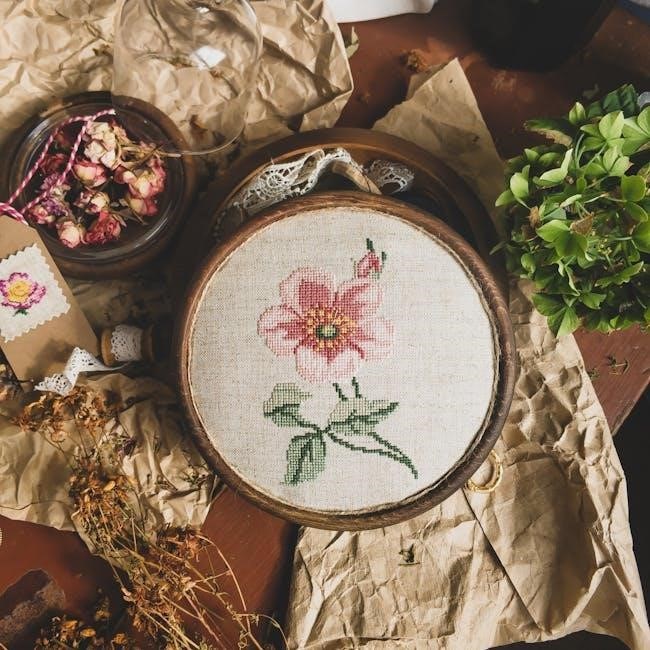
A Brief History of Vintage Sewing Patterns
Vintage sewing patterns originated in the late 19th century‚ revolutionizing home sewing with standardized designs. The 1940s-1950s marked a golden era‚ making elegant dressmaking accessible to all.
The Origin of Commercial Sewing Patterns
Commercial sewing patterns emerged in the late 19th century‚ revolutionizing home sewing. Companies like Butterick (1863) and McCalls (1870) pioneered standardized templates‚ enabling sewers to replicate fashionable designs precisely. Before this‚ garment-making relied on custom drafts or tailors‚ limiting accessibility. The introduction of commercial patterns democratized fashion‚ allowing people to create stylish clothing at home. This innovation coincided with the Industrial Revolution‚ making sewing more accessible and paving the way for modern dressmaking. These early patterns laid the foundation for the diverse range of vintage sewing patterns available today‚ including free PDF downloads.
The Golden Era of Sewing Patterns: 1940s-1950s
The 1940s and 1950s marked the golden age of sewing patterns‚ driven by post-war prosperity and a surge in home dressmaking. Brands like Simplicity‚ Vogue‚ and Butterick became household names‚ offering patterns that reflected the era’s femininity and sophistication. Structured garments with fitted bodices‚ full skirts‚ and intricate details dominated the decade. The 1950s‚ in particular‚ saw the rise of iconic styles like the “New Look” by Dior‚ influencing pattern designs. This era made sewing accessible and fashionable for millions‚ leaving a lasting legacy in the world of vintage sewing patterns‚ which remain popular for their timeless elegance and craftsmanship.
The Evolution of Patterns Through the Decades
Vintage sewing patterns reflect the cultural and social shifts of their eras‚ evolving in design and style. The 1920s-30s introduced flapper dresses and Art Deco influences‚ while the 1940s-50s emphasized structured‚ feminine silhouettes with fitted bodices and full skirts. The 1960s-70s brought mod mini-dresses‚ bell-bottoms‚ and bohemian styles‚ influenced by counterculture movements. Each decade’s patterns capture the spirit of its time‚ offering a window into fashion history. Modern sewists cherish these designs for their unique charm‚ blending nostalgia with modern creativity. The evolution of patterns highlights fashion’s timeless appeal and adaptability‚ inspiring contemporary interpretations of classic styles.

Popular Decades for Vintage Sewing Inspiration
The 1920s-30s brought Art Deco flair‚ while the 1940s-50s emphasized structured elegance. The 1960s-70s introduced mod and bohemian styles‚ each offering unique inspiration for retro sewing projects.
1920s-1930s: The Roaring Twenties
The 1920s-1930s marked a revolutionary era in fashion‚ characterized by liberation and modernity. Free vintage sewing patterns from this period feature flapper dresses‚ dropped waistlines‚ and flowing fabrics like chiffon and silk. The Art Deco influence is evident in geometric patterns and intricate beading. Sewists can explore patterns for fringe-trimmed dresses‚ cloche hats‚ and flowing coats. These designs emphasize a relaxed‚ boyish silhouette‚ reflecting the cultural shift toward women’s independence. The Roaring Twenties also saw the rise of sportswear and knitwear‚ offering a mix of elegance and practicality. Downloading these patterns allows you to recreate the glamour of the Jazz Age with ease.
1940s-1950s: Post-War Elegance
The 1940s and 1950s brought a transformation in fashion‚ shifting from wartime austerity to post-war luxury. Free vintage sewing patterns from this era feature tailored suits‚ fitted waists‚ and full skirts‚ reflecting femininity and sophistication. The 1940s emphasized practicality with shorter hemlines and simpler designs due to fabric rationing‚ while the 1950s celebrated opulence with structured garments and intricate details. Iconic styles like Christian Dior’s “New Look” dominated the 1950s‚ offering a feminine silhouette with padded shoulders and exaggerated curves. These patterns remain timeless‚ blending elegance with modern wearability for sewists seeking classic charm.
1960s-1970s: Retro Mod and Boho Styles
The 1960s and 1970s introduced bold‚ liberated fashion with mod and bohemian influences. Free vintage sewing patterns from this era feature shift dresses‚ mini-skirts‚ and geometric prints‚ reflecting the mod movement’s clean lines and playful designs. The 1970s embraced a more relaxed‚ bohemian style with flowing maxi dresses‚ bell-bottom jeans‚ and peasant tops. These patterns offer a retro charm that appeals to modern sewists‚ blending nostalgia with contemporary flair. Whether recreating iconic mod shifts or boho-inspired garb‚ these free PDF patterns bring the vibrant spirit of the ’60s and ’70s to life in timeless‚ customizable garments.
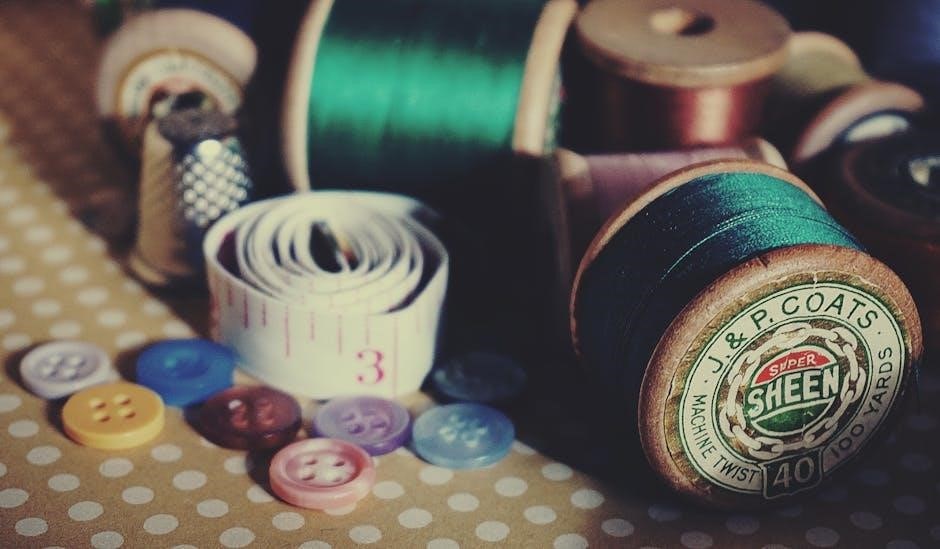
Where to Find Free Vintage Sewing Patterns
Discover free vintage sewing patterns PDFs on online marketplaces‚ specialized websites‚ and thrifty stores. Explore platforms like The Vintage Pattern Shop‚ Archive.org‚ and sewing blogs for retro designs.
Online Marketplaces and Specialized Websites
Online marketplaces and specialized websites are treasure troves for free vintage sewing patterns PDFs. Platforms like The Vintage Pattern Shop‚ Archive.org‚ and Vintage Sewing Pattern Wiki offer a wide array of retro designs. These sites provide scanned historical patterns‚ from 1920s flapper dresses to 1970s bohemian styles. Many patterns are available as downloadable PDFs‚ making it easy to print and use them. Additionally‚ sewing blogs and communities often share free vintage patterns‚ ensuring access to timeless fashion. Whether you’re looking for dresses‚ hats‚ or accessories‚ these resources are perfect for DIY projects and retro-inspired creations.
Thrift Stores‚ Garage Sales‚ and Estate Sales
Thrift stores‚ garage sales‚ and estate sales are fantastic places to uncover hidden gems like vintage sewing patterns. Many people unknowingly discard old patterns‚ making these venues a budget-friendly way to find retro designs. Keep an eye out for charity shops‚ flea markets‚ and estate sales‚ where vintage sewing patterns can often be found at a fraction of their value. While some may require a small purchase‚ others might be bundled with fabric or sewing supplies. These discoveries can add unique‚ one-of-a-kind pieces to your collection‚ offering a tangible connection to the past.
Fabric Stores and Sewing Clubs
Fabric stores and sewing clubs are excellent resources for discovering free vintage sewing patterns. Some stores carry vintage patterns or offer them as free downloads to customers. Sewing clubs and communities often share or trade patterns among members‚ fostering a sense of collaboration and creativity. These groups also provide valuable advice on working with vintage designs. Additionally‚ fabric stores may host workshops or events where vintage patterns are featured. Whether you’re a beginner or an experienced sewer‚ these spaces offer a wealth of resources and expertise to help you bring your vintage sewing projects to life;
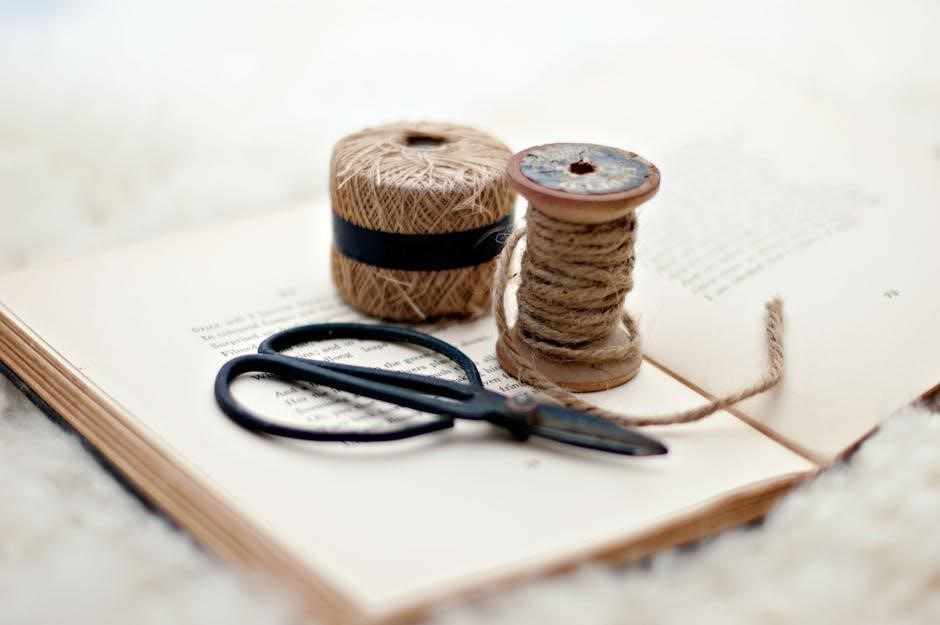
Top Resources for Free Vintage Sewing Patterns
Explore top resources like The Vintage Pattern Shop‚ Online Archives‚ and Sewing Blogs for an array of free vintage sewing patterns. These platforms offer downloadable PDFs and inspiration aplenty!
The Vintage Pattern Shop
The Vintage Pattern Shop is a treasure trove for enthusiasts‚ offering a wide range of reproduced vintage sewing patterns. Specializing in classic designs from iconic brands like Vogue and Simplicity‚ the shop provides high-quality PDFs that cater to various skill levels. While many patterns are paid‚ they occasionally offer free downloads‚ making it a great starting point for beginners. The shop’s collection spans multiple decades‚ ensuring a diverse selection of styles. Whether you’re looking for 1950s dresses or 1970s bohemian designs‚ The Vintage Pattern Shop is a reliable destination for authentic vintage inspiration. Its user-friendly website and organized catalog make it easy to explore and find your next project.
Online Archives and Vintage Sewing Pattern Wiki
Online archives and the Vintage Sewing Pattern Wiki are invaluable resources for free vintage sewing patterns. These platforms offer extensive collections of historical designs‚ spanning from the 1920s to the 1990s. The Vintage Sewing Pattern Wiki boasts over 83‚500 patterns‚ searchable by year or garment type. Websites like Archive.org provide scanned versions of vintage patterns‚ ensuring their preservation for future generations. These repositories are perfect for enthusiasts seeking rare or specific designs. They not only offer free access but also serve as a historical archive‚ showcasing the evolution of fashion and sewing techniques over the decades.
Sewing Blogs and Communities
Sewing blogs and communities are vibrant hubs for vintage sewing enthusiasts. Many bloggers share free patterns‚ tutorials‚ and tips‚ fostering a sense of camaraderie among sewists. British sewing influencers have played a significant role in popularizing vintage styles‚ offering step-by-step guides and modern twists on classic designs. These platforms also provide spaces for sharing projects‚ asking questions‚ and inspiring creativity. Whether you’re a beginner or an experienced seamstress‚ sewing communities are invaluable resources for discovering free vintage patterns and connecting with like-minded crafters who celebrate the art of retro sewing.
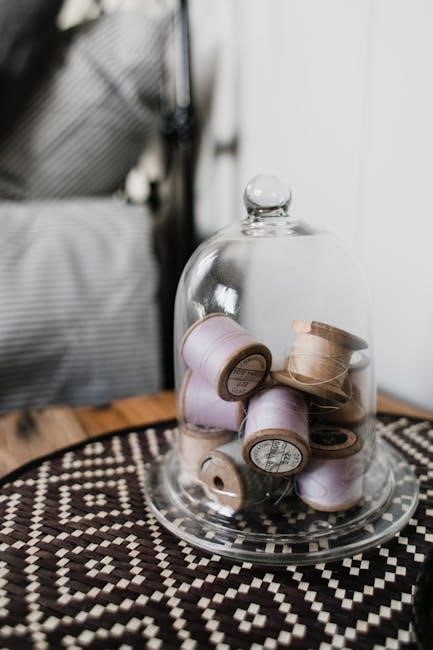
How to Use Vintage Sewing Patterns
Download and print free vintage patterns‚ then follow step-by-step instructions. Choose suitable fabrics‚ adjust sizes if needed‚ and sew with care to create authentic‚ timeless garments.
Downloading and Printing Patterns
Downloading free vintage sewing patterns PDFs is straightforward—simply search online‚ select your design‚ and download. Most sites offer direct PDF links or email downloads. Ensure your printer settings are correct‚ using “actual size” to maintain scale. Patterns may include multiple pages‚ so assemble carefully. Some files come with instructions‚ while others require basic sewing knowledge. Always check for seam allowances‚ as vintage patterns often lack them. Print a test page to confirm sizing before cutting fabric. Once printed‚ trace or cut pieces‚ and you’re ready to sew your timeless garment with ease and precision.
Understanding Pattern Sizes and Adjustments
Vintage pattern sizes differ significantly from modern standards‚ often smaller due to historical fit preferences. A 1950s size 12‚ for instance‚ may equate to a contemporary size 6. Measure carefully and compare to the pattern’s size chart. Adjustments like adding ease‚ lengthening hems‚ or altering darts are common. Consider full bust adjustments or waistline modifications for a better fit. Test changes with a muslin toile before cutting final fabric. These tweaks ensure your vintage garment flatters your modern silhouette while preserving its classic charm and style. Patience and precision are key to achieving the perfect fit.
Choosing the Right Fabric for Vintage Styles
Selecting the right fabric is crucial for achieving an authentic vintage look. Opt for materials popular in past eras‚ such as cotton‚ rayon‚ or silk‚ which drape elegantly and mimic the textures of yesteryear. For structured garments like 1950s dresses‚ consider high-quality wool or satin. Avoid modern stretch fabrics unless specified‚ as they may alter the intended silhouette. Lighter fabrics like voile or lawn are ideal for delicate 1920s designs‚ while heavier fabrics suit 1940s utility styles. Pairing the correct fabric with your vintage pattern ensures a timeless‚ genuine finish that honors the era’s aesthetic and craftsmanship.
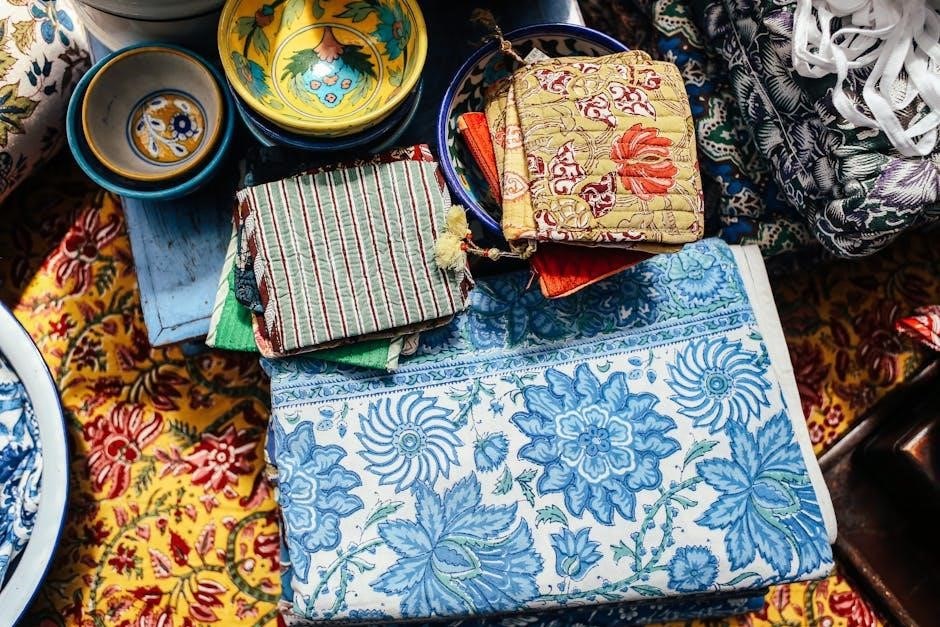
Adjusting Vintage Patterns to Modern Sizes
Adapting vintage patterns to modern sizes ensures a perfect fit. Scale patterns‚ add seam allowances‚ and adjust ease for comfort. Test with muslin before final fabric for accuracy.
Scaling Patterns for Better Fit
Scaling vintage patterns ensures a flawless fit for modern measurements. Use software or printers to enlarge or reduce designs proportionally. Test with muslin to confirm accuracy before cutting final fabric. Always add seam allowances and adjust ease for comfort. This step is crucial for achieving a tailored look while maintaining the original design’s integrity. Proper scaling ensures garments flatter contemporary body types‚ making vintage styles wearable and timeless. Start with a muslin prototype to refine fit before sewing your final piece. This method guarantees a perfect blend of retro charm and modern comfort.
Full Bust Adjustment (FBA)
A Full Bust Adjustment (FBA) is essential for ensuring vintage patterns fit modern body types. Vintage patterns often have smaller bust measurements‚ so adding width without altering the waistline is key. This adjustment involves calculating the difference between your bust size and the pattern’s bust size‚ then incorporating additional fabric through darts or seams. Use a muslin prototype to test the fit before sewing the final garment. Properly executed‚ an FBA ensures a comfortable‚ flattering fit while preserving the pattern’s original design. This step is vital for achieving a polished‚ tailored look in your vintage creations.
Waistline and Hip Modifications
Vintage patterns often feature smaller waistlines and narrower hips compared to modern body types. To achieve a comfortable fit‚ consider adding width to the waistline using side seams or darts. For hip modifications‚ expand the pattern at the side seams to accommodate a fuller silhouette. These adjustments ensure the garment drapes naturally and allows for ease of movement. Always test modifications on a muslin prototype before cutting your final fabric. By tailoring the waistline and hips‚ you can create a flattering‚ custom fit while maintaining the vintage aesthetic of your chosen pattern.
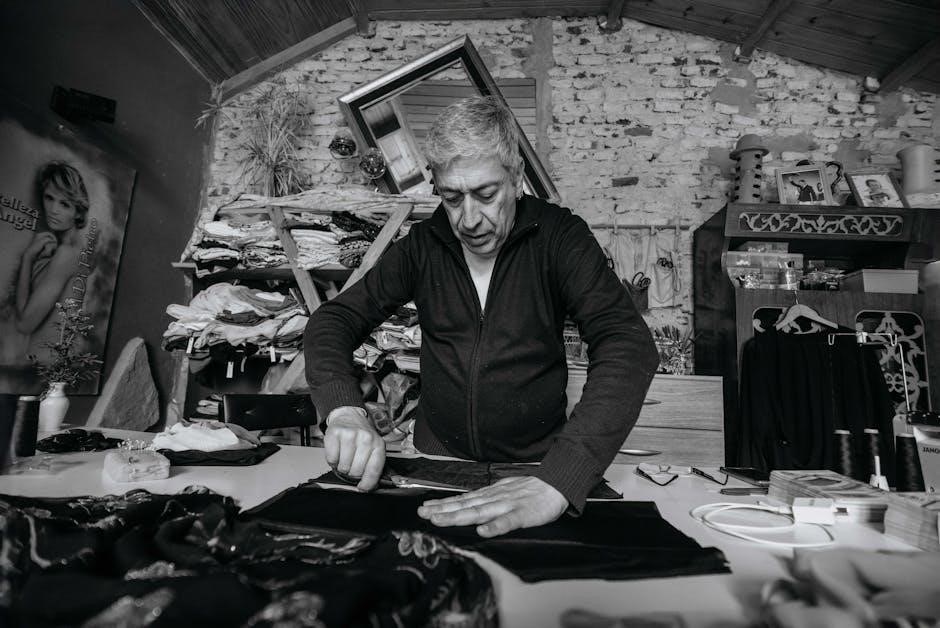
Vintage Lingerie Sewing Patterns
Elevate your wardrobe with free vintage lingerie patterns! Discover garter belts‚ kimonos‚ and high-waisted panties‚ perfect for creating retro undergarments with a touch of timeless elegance and charm.
- Garter belts: Adjustable straps and lace details for a glamorous finish.
- Kimonos: Loose-fit loungewear with wide sleeves and sash belts.
- High-waisted panties: Full coverage and optional lace accents for comfort and style.
Vintage Garter Belt Patterns
Add a touch of elegance to your retro lingerie with vintage garter belt patterns! These patterns feature adjustable straps and a classic high-waist fit‚ perfect for pairing with vintage stockings. Detailed with lace accents‚ they offer both functionality and glamour. Ideal for intermediate sewists‚ these designs require working with delicate fabrics. Download free vintage garter belt patterns in PDF format and create a piece that combines nostalgia with sophistication. Whether for everyday wear or special occasions‚ these patterns bring a timeless charm to your wardrobe. Embrace the art of vintage lingerie sewing with these beautiful‚ historic designs.
Kimonos and Loungewear Patterns
Bring luxury to your loungewear with vintage kimono patterns! These timeless designs‚ popular in the 1930s and 1940s‚ feature a loose‚ flowing fit with wide sleeves and a sash belt. Perfect for silk or satin‚ they are beginner-friendly and ideal for experimenting with elegant fabrics. Download free vintage kimono patterns in PDF format and create a piece that exudes classic sophistication. Whether for lounging at home or as a stylish layering piece‚ these patterns offer a blend of comfort and vintage charm‚ making them a delightful addition to your sewing projects.
High-Waisted Panties and Retro Undergarments
Recreate the timeless pin-up style with high-waisted panties inspired by the 1940s and 1950s. These patterns offer full coverage‚ a comfortable fit‚ and optional lace or satin details for a touch of vintage charm. Perfect for beginners‚ they provide a great introduction to sewing retro undergarments. With free vintage sewing patterns PDFs readily available‚ you can craft authentic pieces that blend nostalgia with modern comfort. Ideal for those who appreciate classic lingerie‚ these designs allow you to create undergarments that are both functional and stylish‚ ensuring a flawless fit and a nod to bygone eras.
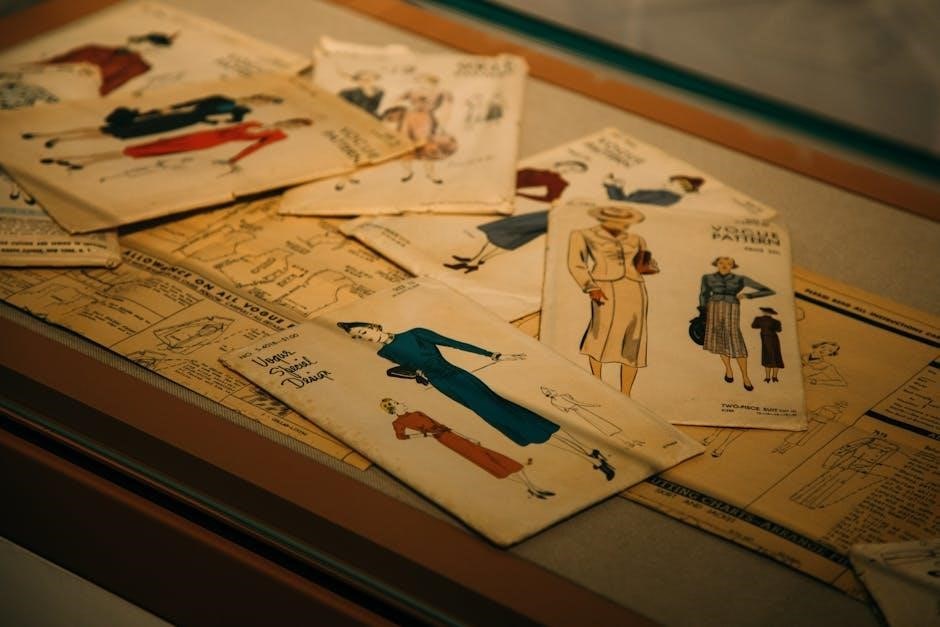
Vintage Knitting Patterns
Explore free vintage knitting patterns PDFs‚ featuring 1940s cable-knit sweaters‚ 1950s button-up cardigans‚ and 1960s mod-style knits. Perfect for creating retro-inspired garments with timeless charm and flair.
1940s Cable-Knit Sweater Patterns
1940s cable-knit sweaters embody classic wartime style with fitted silhouettes and intricate detailing. These patterns‚ often featuring a tailored waist‚ evoke a timeless‚ nostalgic charm. Perfect for intermediate knitters‚ they require worsted weight yarn and patience for cablework.
Available as free vintage knitting PDFs‚ these designs connect modern makers to historical craftsmanship. Ideal for creating cozy‚ durable garments‚ they blend functionality with vintage elegance‚ making them a beloved choice for retro-inspired wardrobes.
1950s Button-Up Cardigan Patterns
1950s button-up cardigans are a quintessential retro staple‚ offering timeless elegance and versatility. Designed to layer over dresses or tops‚ these patterns feature a classic silhouette with a fitted waist and a clean‚ structured look. Often adorned with subtle detailing like buttons or ribbed trims‚ they embody the sophistication of mid-century fashion.
Available as free vintage knitting PDFs‚ these patterns are perfect for crafting cozy‚ nostalgic garments. They blend vintage charm with modern practicality‚ making them a delightful addition to any retro-inspired wardrobe.
1960s Mod-Style Knit Dress Patterns
1960s mod-style knit dress patterns capture the essence of the swinging sixties with sleek‚ modern designs. These patterns feature mini lengths‚ A-line silhouettes‚ and shift dresses that defined the era. Bold geometric patterns‚ bright colors‚ and innovative textures reflect the decade’s vibrant fashion. Perfect for retro enthusiasts‚ these free vintage knitting PDFs offer a chance to recreate iconic mod looks. With their clean lines and futuristic appeal‚ these dresses embody the playful yet sophisticated style of the 1960s‚ making them a must-try for anyone embracing retro fashion.

Additional Resources and Tools
Explore sewing boxes‚ kits‚ and tutorials for vintage patterns. Subscribe to newsletters for tips and inspiration. Join communities to share ideas and enhance your sewing journey with creativity and style.
The Pattern Shop for Reproduced Vintage Designs
The Pattern Shop specializes in reproduced vintage designs‚ offering a wide selection of classic patterns from brands like Vogue‚ Butterick‚ and Simplicity. Perfect for collectors and seamstresses‚ these patterns bring iconic retro fashion to life. From 1950s dresses to 1960s mod styles‚ the shop provides meticulous reproductions that capture the essence of bygone eras. Whether you’re aiming for historical accuracy or a modern twist‚ these patterns are a must-have for any vintage sewing enthusiast‚ ensuring timeless elegance and sophistication in every stitch.
Sewing Tutorials and Online Classes
Enhance your vintage sewing skills with online tutorials and classes! British sewing influencers and bloggers offer step-by-step guides on platforms like YouTube and Instagram‚ showcasing how to recreate 1950s dresses and 1960s mod styles. Websites like LingerieSewingClass.com provide detailed courses for retro undergarments‚ while others offer free sewing patterns and tips for adjusting vintage designs. These resources cater to both beginners and experienced sewers‚ ensuring a smooth journey into the world of retro fashion. With comprehensive guides and practical advice‚ you can master the art of vintage sewing and create timeless‚ elegant garments with ease.
Sustainability and Slow Fashion with Vintage Sewing
Vintage sewing aligns seamlessly with the slow fashion movement‚ promoting sustainability by reducing waste and encouraging upcycling. By repurposing fabrics and garments‚ you create unique‚ timeless pieces that stand against fast fashion. Free vintage patterns inspire craftsmanship‚ allowing for precise tailoring and a perfect fit. This approach not only preserves the art of traditional sewing but also fosters a deeper connection to the garments you create. Embrace eco-friendly practices and celebrate individuality through the beauty of retro designs‚ making fashion both sustainable and meaningful;
Embrace the timeless charm of vintage sewing patterns‚ where sustainability meets creativity. Transform your wardrobe with retro flair‚ crafting unique garments that tell a story of the past.
The Joy of Creating with Vintage Patterns
Creating with vintage patterns is a journey through time‚ blending nostalgia with modern flair. It’s about reconnecting with the stories behind each stitch and crafting garments that carry the essence of the past. With free vintage sewing patterns PDFs‚ you can easily access designs that once adorned fashion icons‚ from elegant 1950s dresses to bohemian 1970s blouses. The process is therapeutic‚ offering a slow‚ meditative escape from fast fashion. It’s not just sewing—it’s about preserving history‚ celebrating craftsmanship‚ and wearing a piece of the past with pride. Let the joy of vintage patterns inspire your next creative project!
Final Tips for Starting Your Vintage Sewing Journey
Embarking on your vintage sewing adventure? Start by exploring free PDF patterns online‚ perfect for beginners. Always test designs with muslin before cutting final fabrics. Adjust patterns to modern sizes‚ considering differences in proportions. Add seam allowances and ease for comfort. Experiment with fabrics suited to the era‚ like cotton for 1950s dresses or silk for 1930s kimonos. Join sewing communities for tips and inspiration. Embrace the process‚ and don’t hesitate to alter patterns for a perfect fit. With patience and creativity‚ you’ll craft timeless garments that reflect your unique style and connect you to the artistry of the past.